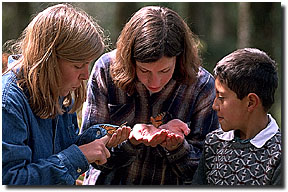|

 n Wednesday, we were at Denise's house at about
n Wednesday, we were at Denise's house at about
1 p.m. in Elmont, New York. We were playing in the driveway. The day was hot and sunny. We saw a monarch butterfly. It was alone." -- Email from two fourth graders at the Clara H. Carlson school on Long Island The sight of a monarch butterfly on the wing or sunning itself on the windowsill triggers reflexive reactions of delight and awe. The mystical power possessed by these delicate, beautiful insects -- which seem to appear from nowhere every spring and summer -- makes them welcome wherever they alight. In fact, monarchs nest in the mountains west of Mexico City. Every year, after emerging from their cocoons and drying their wings for a moment or two, the newest generation starts fluttering north, eventually covering as much as 2,500 miles. This incredible journey illustrates the mysterious power of instinct, for it leads the butterflies on an unerring course to ancestral destinations they have never visited themselves -- monarch parent generations die before their offspring are born. Since 1994, through a remarkable program sponsored by an interactive education provider called "Journey North," 25,000 middle-school students from Mexico to Canada have been using email and the Internet to track the migration each year. By reporting monarch sightings in their own hometowns, participants will help create a continentwide digital map of the migration in progress. And in weekly "ask the expert" sessions on the Net, they will be able to communicate directly with scientists and participate in current research.
|









 n Wednesday, we were at Denise's house at about
n Wednesday, we were at Denise's house at about 